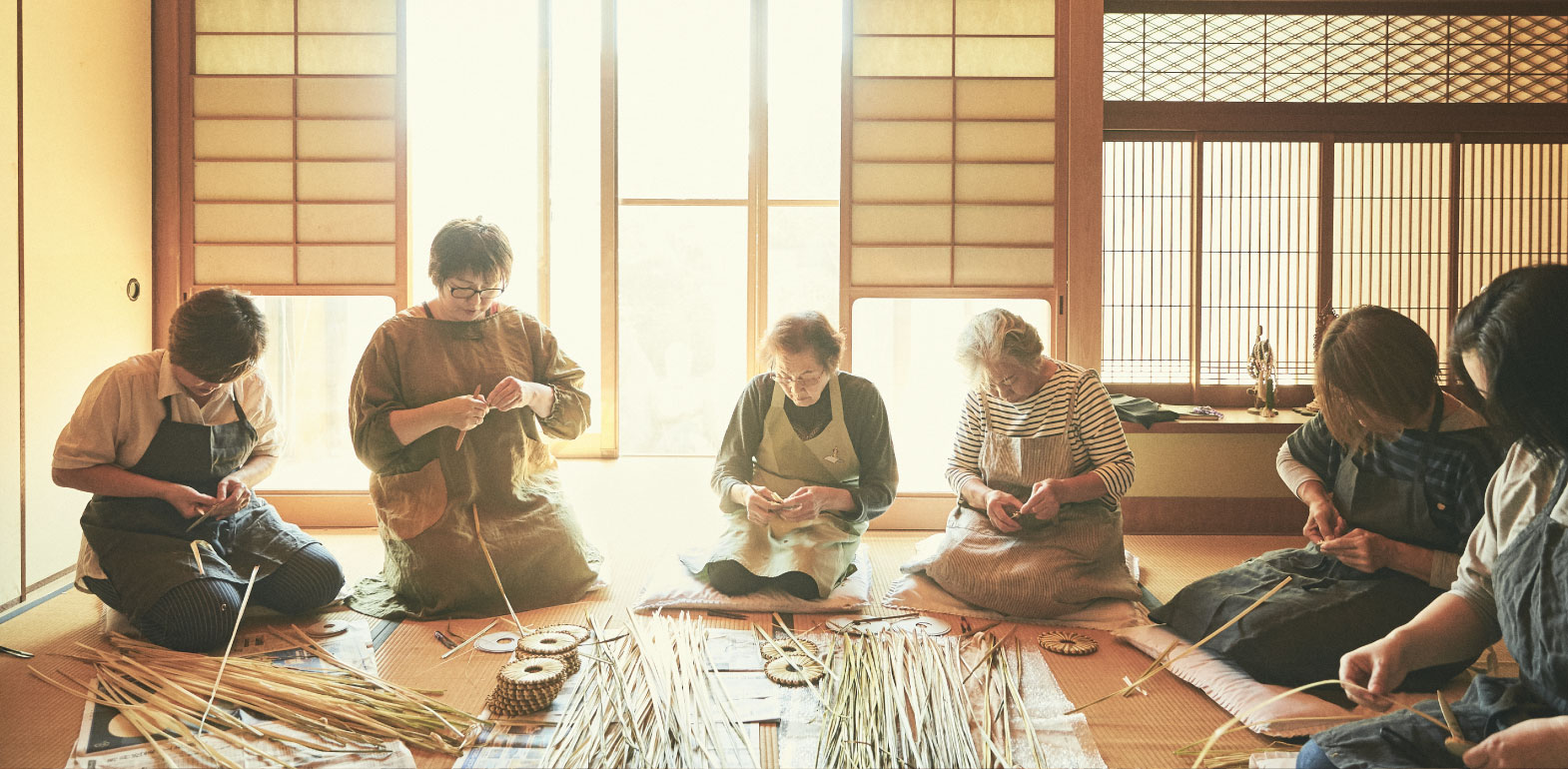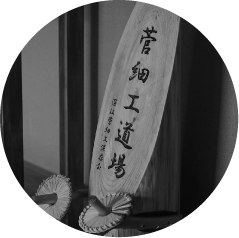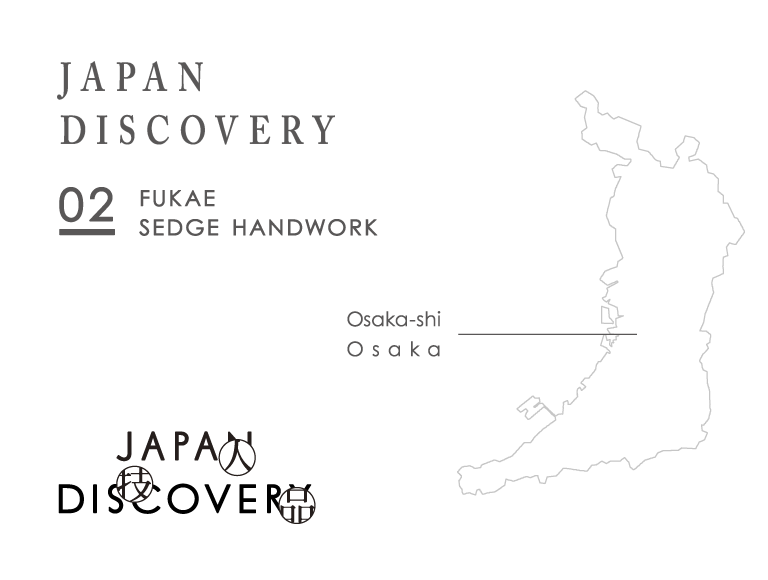


Suge Zaiku (sedge weaving), a traditional handicraft that has been fostered
in Fukae, Osaka, from around 2000 years ago.
Sugegasa (the wide-brimmed sedge hat) in particular, is so highly appreciated
that these hats are used for important events including Daijyosai, a ritual linked to the succession
of a new emperor, and Ise Jingu’s Shikinen Sengu, a regular ceremony to construct
a new shrine and transfer the enshrined object from the old to the new.
On this occasion we visited Fukae Suge Zaiku Preservation Society,
which preserves the techniques for this rare traditional handicraft.
Interview at Fukae Suge Zaiku Preservation Society, with Mrs. Mayumi Shimatani,
a traditional craftsperson certified by Osaka Prefecture.
Photo by Makoto Koike
Strenuous efforts made on a daily basis
to revive traditional techniques once nearly lost for ever
It was around 2000 years ago that Suga Zaiku began to be crafted in Fukae, located in the Higashinari Ward of Osaka City. Fukae was once a marshland and as it was suitable for growing sedge, an essential material for Suge Zaiku, a clan of traditional hat weavers settled here and began to make the Sugegasa (a wide-brimmed sedge hat), and this was apparently how Suge Zaiku in Fukae began. Sedge growers also began making Suge Zaiku during off-seasons and thus, Suge Zaiku has been passed on as a traditional handicraft to this day.
Unfortunately, the progress of land development for housing in Osaka city resulted in the sedge fields disappearing in the late 50s and early 60s. Sedge was easily obtainable from other prefectures, but the demand for Suge Zaiku itself decreased with time and by the 1980s, there was only one workshop where the Suge Zaiku techniques were being passed on. Then came a request for Sugegasa to dedicate to the shrine for the 60th Ise Jingu’s Shikinen Sengu. “Something must be done to
preserve Suge Zaiku!” The workshop finally made up its mind and Mrs. Masako Sawada, the mother of the Society’s current representative, Mrs. Mayumi Shimatani, founded the Fukae Suge Zaiku Preservation Society in 1988. “At that time, my mother became an instructor for this handicraft and taught the making of Suge Zaiku to housewives living nearby,” said Mrs. Shimatani.
After that time, Sugegasa has always been dedicated to the shrine, whenever Ise Jingu’s Shikinen Sengu is held. In 2016, thanks to dedicated efforts of Mrs. Shimatani, Suge Zaiku was designated as one of Osaka Prefecture’s traditional handicrafts, contributing to the improvement of awareness towards the handicraft. Recently more and more orders come from small private shops selling Japanese general merchandise, and there are increasing opportunities to make pot stands and coasters.



Once you start, you become completely absorbed…
the wonderful charm of Suge Zaiku crafting
Original members at the time of founding of the Fukae Suge Zaiku Preservation Society were six housewives. Through holding workshops nearby, the society scouted for people who came to the workshops for about a year. Training was offered to them at the society for another year, and only those who wished to continue became regular members. After attending and completing further training sessions, four times a month for three years, members were finally allowed to be involved in making the handicrafts sold as Suge Zaiku.
The main Suge Zaiku products are pot stands, coasters and round seating cushions. Sugegasa, unique hats worn by pilgrims who make journeys to Shikoku’s 88 sacred sites, are one type of Suge Zaiku. During the interview, the society members made coasters for us. Two card discs of different sizes were laid on top of one another and, leaf by leaf, sedge leaves were carefully threaded through and wrapped around them, On this occasion the logo of CHAIN, the sun, was adapted as the design of the coaster. The same number of yellowish sedge leaves as on the logo’s motif were wrapped around in radial lines to imitate our logo. “The work is really very simple
but needs patience,” said Mrs. Shimatani. Sedge leaves are a natural material and each leaf comes in a unique shape and size, but in order for finished items to look beautiful, you must choose leaves that are similar in width, thickness and color. This process of selecting leaves is taxing and takes a lot of time for the inexperienced.
Then, even if you work very carefully, if you are not satisfied with the look of the finished item, you end up undoing the work and doing it all over again. Although it is such a long journey to become a proper Suge Zaiku craftsperson, no one yet has given up half way. The society was initially formed with six housewives living nearby, but today the number has grown to 15, including some members who are male, and some female members who also have other jobs. The members commented: “No matter how many years you try, it is still difficult and sometime very frustrating. Every time I get frustrated, I hope to improve, and I have been continuing like this for decades.” We also heard: “I am drawn to it for some reason. I simply find myself making Suge Zaiku even when I’m at home.” They all seem to be mesmerized by the charm of Suge Zaiku, in a way that is very simple and natural.




The society’s mission is to pass the inherited traditional artifacts on to the next generation
To preserve the traditional handicrafts called Suge Zaiku, the society exerts its greatest efforts into public relations activities targeting younger generations. From the beginning of the preservation society’s founding, it has continued to deploy activities to familiarize primary school children with Suge Zaiku, collaborating with local primary schools. “Every November, we ask Grade 3 students to plant seedlings in the Suge field. In the coming summer, when they move up to Grade 4, we ask them to harvest what they planted, and in the fall they and their parents are invited to the Suge Zaiku workshop to experience handcrafting.” Children who have never
stepped into a muddy field with bare feet are always very excited, and this experience seems to form strong impressions.
These days, adults who remember these Suge Zaiku experiences during their primary school years, are more likely to visit the society for interview, or to order Suge Zaiku products. “I’m so happy they remember us even when they are grown up,” said Mrs. Shimatani with a cheerful smile. “My mission is to pass on the inherited art of traditional handicrafts to future generations,” she told us, in a determined tone.



![]()

3-5-17 Fukae minami,
Higashinari-ku,
Osaka-shi,
Osaka Prefecture 537-0002
TEL +81-88-855-0426













